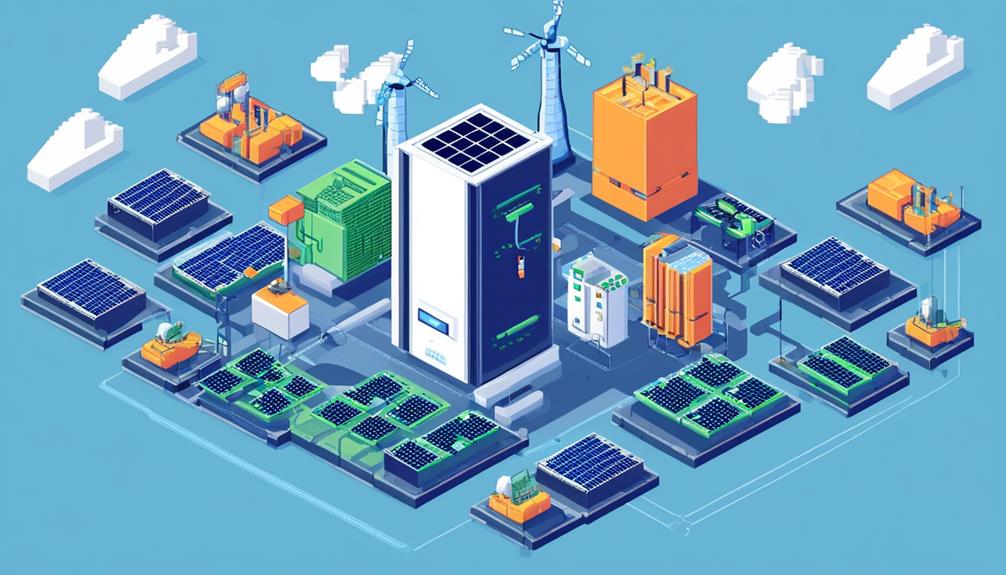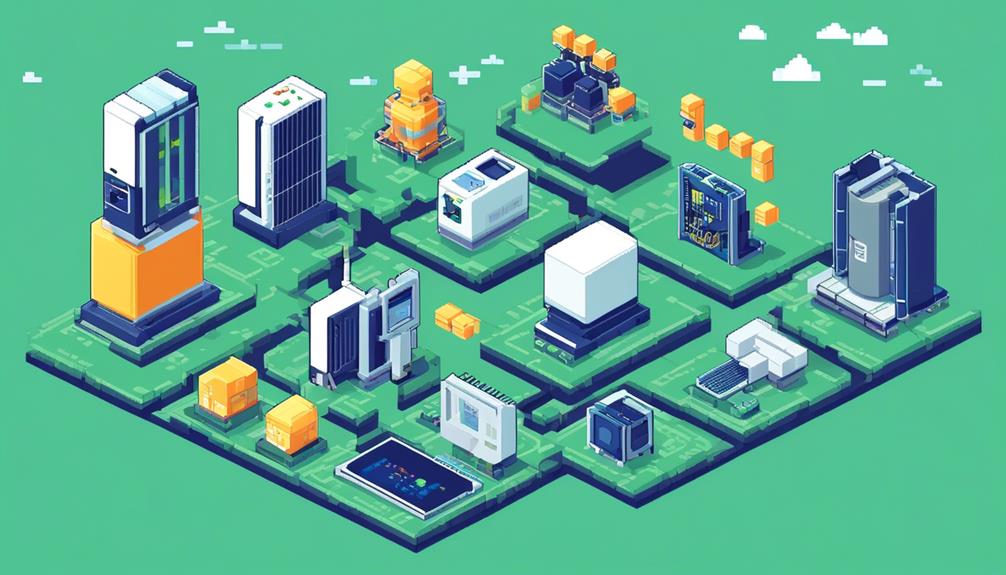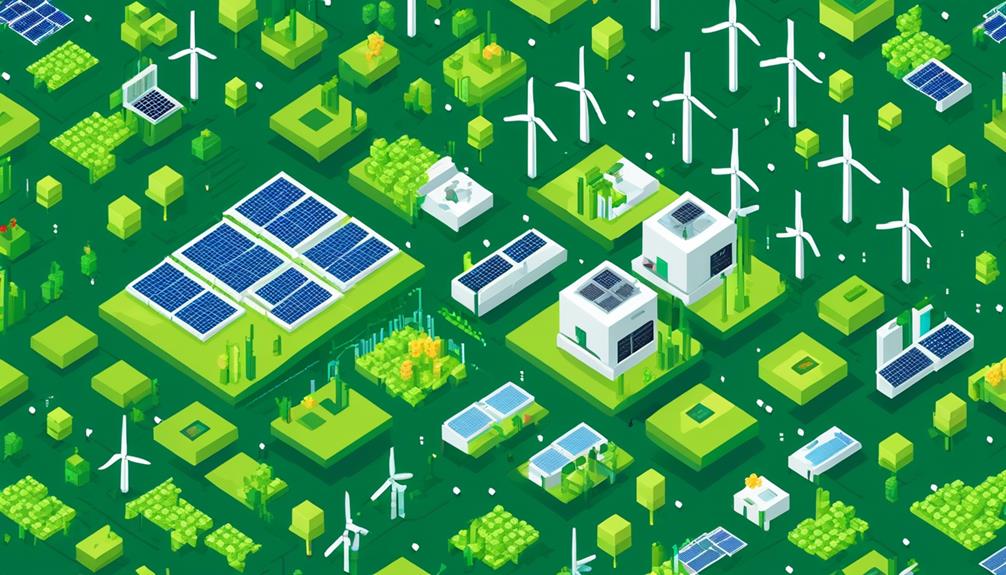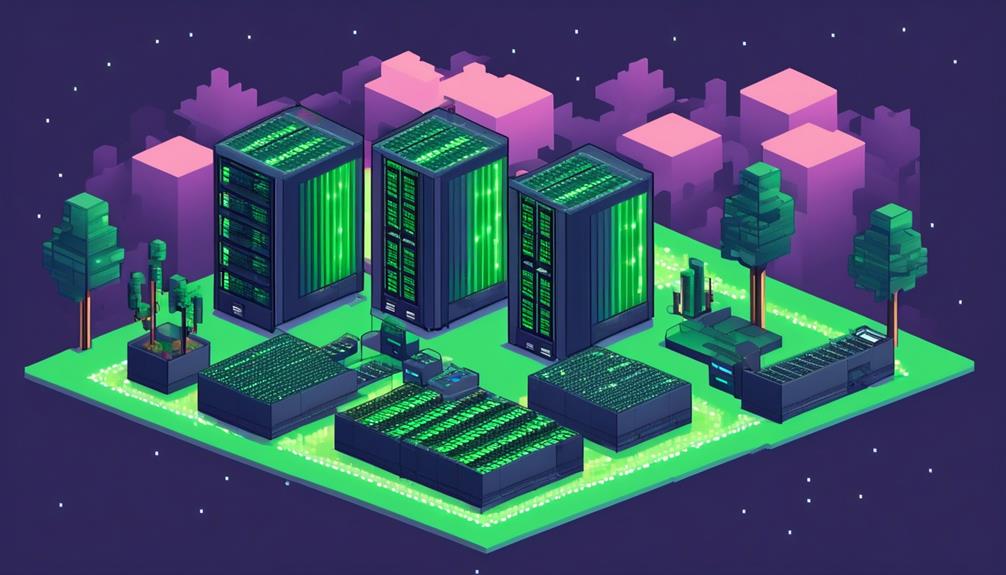In the realm of cloud computing, the implementation of energy-efficient hardware has emerged as a crucial area of focus. With the ever-increasing demand for cloud services, data centers consume substantial amounts of power, resulting in significant carbon emissions. Therefore, optimizing energy utilization and reducing power consumption through the use of energy-efficient hardware has become paramount.
This discussion aims to explore the various strategies, techniques, and breakthroughs in energy-efficient hardware that are revolutionizing the cloud computing landscape. From load balancing and virtualization to dynamic voltage and frequency scaling, we will delve into the intricate details of how these approaches contribute to a more sustainable future for cloud computing.
Join us as we uncover the significant impact of energy-efficient hardware and the steps being taken to reduce the carbon footprint in this vital domain.
Key Takeaways
- Energy-efficient hardware is crucial for minimizing power consumption in data centers.
- Techniques such as Dynamic Voltage and Frequency Scaling (DVFS) and virtualization contribute to optimizing energy efficiency in cloud computing hardware.
- Adoption of renewable energy sources and green computing initiatives drive the adoption of energy-efficient hardware.
- Energy-efficient hardware solutions lead to cost savings, extended hardware lifespan, and a reduced carbon footprint in cloud computing.
Energy-Efficient Hardware Solutions

Energy-efficient hardware solutions play a crucial role in minimizing power consumption and maximizing performance in cloud computing environments. Cloud computing relies on large-scale data centers that consume significant amounts of energy. Therefore, optimizing the energy efficiency of the hardware used in these data centers is of utmost importance.
One technique commonly employed in energy-efficient hardware solutions is Dynamic Voltage and Frequency Scaling (DVFS). DVFS adjusts the voltage and clock frequency of the hardware components based on the workload demand. By dynamically scaling these parameters, energy consumption can be minimized while still meeting the performance requirements. This technique is particularly effective in cloud computing environments where workloads vary over time.
In addition to DVFS, other energy-saving techniques are employed to enhance the energy efficiency of cloud computing hardware. Virtualization is one such technique that allows multiple virtual machines to run on a single physical server, reducing the hardware resources required and thus minimizing power consumption. Efficient cooling systems, such as liquid cooling or intelligent airflow management, also contribute to energy savings by reducing the power needed to cool the hardware components.
To further promote energy efficiency, cloud data centers are increasingly adopting renewable energy sources. Solar and wind power are harnessed to generate electricity, reducing reliance on traditional energy sources and lowering the carbon footprint associated with cloud computing infrastructure.
Green computing initiatives and policies also play a significant role in driving the adoption of energy-efficient hardware solutions. These initiatives promote environmentally friendly practices in the design, manufacture, use, and disposal of computer hardware. By implementing energy-efficient hardware solutions and embracing green computing principles, cloud computing can significantly reduce its power consumption and contribute to a more sustainable future.
Benefits of Sustainable Cloud Computing
Cloud computing has emerged as an environmentally conscious solution, optimizing energy utilization and promoting sustainable practices in data centers and IT infrastructure. Green cloud computing offers numerous benefits, including reduced power consumption, minimized CO2 emissions, and enhanced energy efficiency.
One significant advantage of sustainable cloud computing is the optimization of power management. Techniques such as Dynamic Voltage and Frequency Scaling (DVFS) dynamically adjust the voltage and frequency of processors to match workload demands. This approach reduces power consumption by enabling processors to operate at lower power levels during periods of low activity. Additionally, efficient resource allocation ensures that virtual machines are consolidated onto fewer physical servers, resulting in reduced power consumption and improved energy efficiency.
Another benefit of sustainable cloud computing is the promotion of renewable energy sources. By adopting renewable energy, such as solar or wind power, data centers can significantly reduce their carbon footprint. Organizations can also maximize power usage efficiency by implementing energy-efficient hardware solutions. This not only reduces energy consumption but also leads to cost savings and extended hardware lifespan.
Transitioning to sustainable cloud computing solutions also helps organizations comply with environmental regulations and enhances their reputation for sustainability. By implementing eco-friendly practices, organizations can demonstrate their commitment to reducing their environmental impact. This can attract environmentally conscious customers and investors and contribute to a positive brand image.
Impact of Energy-Efficient Hardware

The utilization of energy-efficient hardware plays a pivotal role in optimizing energy consumption and promoting sustainability in cloud computing environments. By implementing energy-efficient hardware, cloud service providers can significantly reduce their power consumption and contribute to energy savings.
Here are some key impacts of utilizing energy-efficient hardware in cloud computing:
- Reduced power consumption: Energy-efficient hardware, such as Intel's Xeon processors or ARM-based chips, consume minimal energy while delivering high performance. This leads to a significant reduction in power consumption in data centers, resulting in lower energy costs and a smaller carbon footprint.
- Enhanced energy efficiency: Energy-efficient hardware is designed to maximize performance per watt. By using advanced technologies like Dynamic Voltage and Frequency Scaling (DVFS), cloud service providers can dynamically adjust the voltage and frequency of their hardware components, optimizing energy efficiency and minimizing unnecessary power consumption.
- Green computing practices: The adoption of energy-efficient hardware aligns with the principles of green computing, which promotes eco-friendly use of computers and resources. By investing in energy-efficient hardware, cloud service providers contribute to reducing the environmental impact of their services, making cloud computing a greener technology.
- Environmental benefits: The use of energy-efficient hardware in cloud computing helps in conserving natural resources and reducing greenhouse gas emissions. It contributes to creating a more sustainable IT infrastructure, minimizing the carbon footprint associated with cloud services.
- Extended hardware lifespan: Implementing power management techniques and efficient cooling systems not only reduce power consumption but also contribute to extending the lifespan of hardware components. By ensuring optimal operating conditions, energy-efficient hardware can have a longer lifespan, reducing electronic waste and promoting resource efficiency.
Strategies for Implementing Green Computing
One effective approach to promoting eco-friendly practices in computing is by implementing various strategies for green computing. These strategies aim to reduce power consumption, optimize energy efficiency in cloud computing, and minimize the environmental impact of hardware components.
One key strategy is the use of virtualization technology, which optimizes resource utilization, reduces power consumption, cooling requirements, and physical space. By running multiple virtual machines on a single physical server, organizations can achieve higher efficiency and reduce energy waste.
Another important strategy is the use of energy-efficient processors. Processors such as Intel's Xeon processors or ARM-based chips deliver high performance while consuming minimal energy. By using these processors in cloud servers, organizations can achieve significant energy savings. Additionally, harnessing renewable energy sources like solar or wind power can further reduce reliance on traditional energy sources and lower the carbon footprint of cloud computing operations.
Improved cooling techniques also play a crucial role in implementing green computing strategies. Techniques such as hot and cold aisle containment, liquid cooling, and air-side economizers optimize cooling efficiency and minimize energy wastage. By ensuring that hardware components are kept at optimal temperatures, organizations can reduce the energy required for cooling and extend the lifespan of their hardware.
Implementing power management techniques, such as adjusting power settings and schedules, can also contribute to energy savings. By reducing power consumption during periods of low usage or implementing sleep modes, organizations can further enhance the energy efficiency of their cloud computing infrastructure.
Breakthroughs in Energy-Efficient Devices

Breakthroughs in energy-efficient devices have led to significant advancements in device power optimization, green computing technologies, and energy-efficient hardware solutions.
These developments have resulted in processors that deliver high performance while minimizing energy consumption, displays that consume less power, storage solutions that offer faster performance and lower power consumption, and smart power management software and hardware that reduce energy waste.
Additionally, the use of innovative materials and manufacturing processes has contributed to sustainable computing by incorporating recycled materials and reducing hazardous substances.
Device Power Optimization
Device power optimization is a critical area of focus in the development of energy-efficient devices. It aims to maximize performance while minimizing energy consumption. This is achieved through various techniques and technologies that improve energy efficiency and reduce power usage.
Some of the breakthroughs in device power optimization include:
- Energy-efficient processors: These processors optimize their performance to consume less power while delivering the required computing resources. This not only improves energy efficiency but also extends battery life in laptops and mobile devices.
- High-efficiency displays: Technologies like OLED consume less power compared to traditional LCDs, making them more energy efficient.
- Energy-efficient storage solutions: Solid-state drives (SSDs) offer faster performance and lower power consumption compared to traditional hard disk drives (HDDs.
- Smart power management software and hardware: These enable intelligent power usage and reduce energy waste by efficiently managing power supply to different components.
- Load balancing in cloud services: By distributing computing resources across multiple servers, load balancing reduces energy consumption by efficiently utilizing available resources.
Green Computing Technologies
Green computing technologies have revolutionized the field of energy-efficient devices, offering breakthroughs in reducing power consumption and promoting sustainability. In the context of cloud computing, energy-efficient hardware plays a crucial role in minimizing the environmental impact of data centers. By optimizing power usage, these technologies help reduce CO2 emissions and lower energy costs.
One significant area of focus is energy-efficient computer equipment. Processors that balance performance and energy consumption improve the power efficiency of laptops and mobile devices, extending battery life. High-efficiency displays, such as OLED, consume less power than traditional LCDs. Similarly, solid-state drives (SSDs) provide faster performance and lower power consumption compared to traditional hard disk drives (HDDs).
Moreover, smart power management software and hardware enable intelligent power usage, reducing energy waste. These technologies help regulate power consumption by networking devices, ensuring efficient data transmission and processing.
Energy-Efficient Hardware Solutions
Energy-efficient hardware solutions have made significant advancements in improving power consumption and performance, contributing to a more sustainable and efficient computing environment. These breakthroughs in energy-efficient devices include:
- Voltage and Frequency Scaling: This technique adjusts the voltage and frequency of processors based on workload demands, reducing energy consumption during periods of lower activity.
- Energy usage in data: Efficient data storage and retrieval mechanisms, such as solid-state drives (SSDs), minimize energy consumption while ensuring fast access to data.
- Operating systems and software: Optimized software algorithms and power management features reduce energy usage by efficiently utilizing hardware resources.
- Systems and software applications: Energy-aware applications and operating systems can dynamically adjust resource allocation to minimize energy consumption.
- VM migration: Virtual machine (VM) migration techniques enable energy-efficient resource allocation by consolidating workloads onto fewer physical servers, reducing overall energy usage.
These advancements in hardware and software play a crucial role in reducing the amount of energy required for computing, leading to more sustainable and environmentally-friendly solutions.
Importance of Reducing Carbon Footprint

Minimizing the carbon footprint of cloud computing is an imperative task in order to mitigate the environmental impact caused by the power consumption and CO2 emissions of data centers. The concept of green computing promotes the eco-friendly use of computers and their resources, and this extends to cloud computing as well.
As more businesses and individuals rely on cloud services, it becomes crucial for service providers to take measures to reduce their environmental impact. One of the key factors in reducing the carbon footprint of cloud computing is the utilization of energy-efficient hardware. Internet service providers are increasingly investing in high-performance, energy-efficient servers and data centers to minimize their energy consumption and greenhouse gas emissions.
Techniques like Dynamic Voltage and Frequency Scaling (DVFS) are employed to optimize the energy utilization of computing systems, allowing them to operate at lower power levels when not performing demanding tasks. By implementing energy-efficient hardware solutions, service providers can significantly reduce their carbon emissions.
Data centers, which consume substantial amounts of power, release a significant amount of CO2 into the atmosphere. By adopting energy-efficient practices, such as reducing idle power consumption and maximizing server utilization rates, service providers can minimize their environmental impact.
Frequently Asked Questions
What Is Energy-Efficient Cloud Computing?
Energy-efficient cloud computing refers to the practice of optimizing energy utilization in cloud services to reduce environmental impact. It involves the use of strategies like dynamic voltage and frequency scaling (DVFS) to minimize energy consumption.
This approach offers numerous benefits, including reduced CO2 emissions, compliance with environmental regulations, and enhanced brand reputation. Successful case studies showcase the positive impact of energy-efficient cloud computing on environmental sustainability.
However, there are challenges and limitations to consider, and the role of energy-efficient hardware in reducing carbon footprint is crucial.
Future trends aim to further improve energy efficiency in cloud computing technologies.
What Is Energy-Efficient Computing Devices?
Energy-efficient computing devices refer to hardware devices that are designed to minimize energy consumption while maintaining optimal performance. These devices employ techniques such as dynamic voltage and frequency scaling (DVFS) and power management to reduce energy usage.
The benefits of energy-efficient computing include lower operational costs, reduced carbon emissions, and a more eco-friendly computing environment. However, implementing energy-efficient computing devices can pose challenges, and ongoing innovations in energy-efficient processors and chips are necessary to further advance this technology.
The future trends in energy-efficient computing technology are expected to bring even more advancements in energy efficiency.
What Is the Hardware in Cloud Computing?
Hardware plays a crucial role in cloud computing, as it encompasses all the physical components necessary for the operation of cloud services. This includes servers, storage devices, networking equipment, and other infrastructure components.
Hardware optimization is of utmost importance in cloud computing to ensure efficient utilization of resources and maximize performance. Hardware virtualization enables the creation of virtual machines, allowing for efficient resource allocation and scalability. Specialized hardware, such as GPUs and FPGAs, can enhance the performance of specific tasks in cloud computing.
However, managing hardware resources and addressing hardware failures can be challenging. Emerging trends in cloud computing hardware include the use of edge computing devices and the integration of artificial intelligence capabilities.
Advancements in hardware technology hold promising prospects for the future of cloud computing, enabling higher performance, energy efficiency, and scalability.
Is Cloud Storage Energy-Efficient?
Cloud storage has the potential to be energy-efficient due to its virtualized nature, as it allows for efficient resource utilization. Green cloud computing focuses on optimizing energy consumption in cloud data centers by employing techniques like Dynamic Voltage and Frequency Scaling (DVFS) and power management.
This not only helps in reducing energy consumption but also minimizes the environmental impact of cloud services.
Additionally, the use of renewable energy sources and sustainable infrastructure further enhances the energy efficiency of cloud storage.
